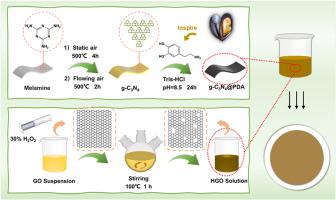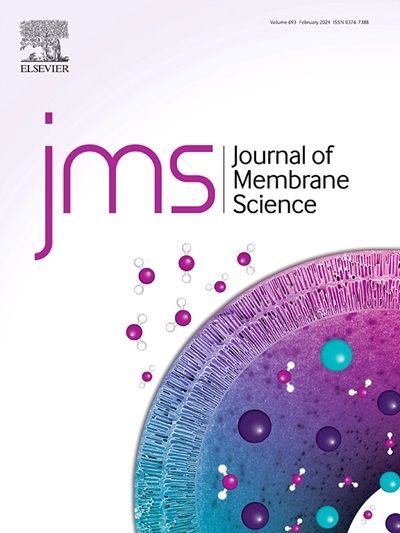通过蚀刻和插层协同策略实现光催化自清洁孔状氧化石墨烯膜,以实现高效染料分离
IF 8.4
1区 工程技术
Q1 ENGINEERING, CHEMICAL
引用次数: 0
摘要
凭借独特的渗滤机制,基于氧化石墨烯(GO)的膜已在染料分离领域广泛试用。然而,长期以来,渗透性和选择性之间的权衡以及膜污染问题限制了其实际应用。在此,我们采用蚀刻和插层的协同策略来制造一种新型复合纳滤膜。通过一种简单的溶液加工方法制备了霍利氧化石墨烯(HGO),在 GO 纳米片上生成了面内纳米孔,从而提高了渗透性。为了提高复合膜的选择性,我们将聚多巴胺(PDA)改性石墨相氮化碳(g-C3N4)插层到 HGO 薄片中。在此过程中,它巧妙地将高效的染料分离性能、令人满意的化学稳定性和优异的自清洁性能结合在一起。直观的结果是,M2 膜(g-C3N4@PDA: HGO = 0.75:1)获得了惊人的纯水通量(49.6 L m-2 h-1)和对各种染料的良好去除率(99%)。在恶劣环境中连续震荡一个月后,膜结构仍然完好无损。即使在运行 60 小时后(每隔 10 小时进行可见光自清洁),复合膜仍能提供可持续的分离性能。因此,这种合作策略为基于 GO 的高效膜的制造提供了一种简单易行的方法。本文章由计算机程序翻译,如有差异,请以英文原文为准。

Photocatalytic self-cleaning holey graphene oxide membranes by a synergistic strategy of etching and intercalation for efficient dye separation
By virtue of the unique percolation mechanism, graphene oxide (GO)-based membrane has been broadly trialed in the field of dye separation. However, the trade-off between permeability and selectivity, together with membrane contamination, has long limited its practical application. Herein, a synergistic strategy of etching and intercalation was applied to fabricate a novel composite nanofiltration membrane. Holey graphene oxide (HGO) was prepared via a simple solution processing method, which generated in-plane nanopores on GO nanosheets, resulting in improved permeability. To enhance the selectivity of the composite membrane, we intercalated polydopamine (PDA)-modified graphitic phase carbon nitride (g-C3N4) into HGO laminates. During the process, a skillful combination of efficient dye separation performance, satisfactory chemical stability and superior self-cleaning property were given to it. What can be found intuitively was that M2 membrane (g-C3N4@PDA: HGO = 0.75:1) obtained an impressive pure water flux (49.6 L m−2 h−1) and a good removal of various dyes (>99 %). The membrane structure was still intact after one month of continuous shaking in a harsh environment. Even after 60 h of operation (with visible light self-cleaning at 10 h intervals), the composite membrane still provided sustainable separation performance. Therefore, this collaborative strategy presents a facile and perspective approach for the fabrication of highly efficient GO-based membrane.
求助全文
通过发布文献求助,成功后即可免费获取论文全文。
去求助
来源期刊

Journal of Membrane Science
工程技术-高分子科学
CiteScore
17.10
自引率
17.90%
发文量
1031
审稿时长
2.5 months
期刊介绍:
The Journal of Membrane Science is a publication that focuses on membrane systems and is aimed at academic and industrial chemists, chemical engineers, materials scientists, and membranologists. It publishes original research and reviews on various aspects of membrane transport, membrane formation/structure, fouling, module/process design, and processes/applications. The journal primarily focuses on the structure, function, and performance of non-biological membranes but also includes papers that relate to biological membranes. The Journal of Membrane Science publishes Full Text Papers, State-of-the-Art Reviews, Letters to the Editor, and Perspectives.
 求助内容:
求助内容: 应助结果提醒方式:
应助结果提醒方式:


